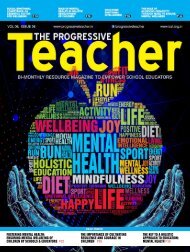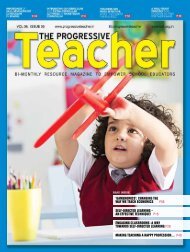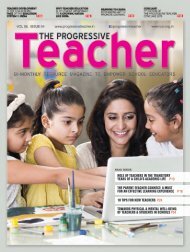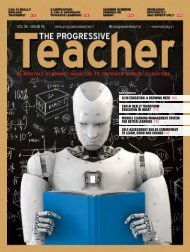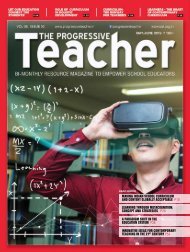The Progressive Teacher Vol 03 Issue 05
This issue of The Progressive Teacher focuses on "Teaching of Social Studies". The magazine provides guidance to the teachers by their peers and school leaders for tackling challenges with innovative ideas.
This issue of The Progressive Teacher focuses on "Teaching of Social Studies". The magazine provides guidance to the teachers by their peers and school leaders for tackling challenges with innovative ideas.
Create successful ePaper yourself
Turn your PDF publications into a flip-book with our unique Google optimized e-Paper software.
teaching<br />
Are we<br />
overlooking handwriting<br />
skill in schools?<br />
–Mohanakannan P<br />
Some may wonder why<br />
students should learn to<br />
write in cursive or print in<br />
the age of tablets and phones.<br />
Won’t everyone just be typing<br />
and dictating in the future?<br />
While electronic devices have<br />
added an element of ease to the<br />
writing process, the evidence is<br />
rising that putting pen to paper<br />
has aids that typing cannot<br />
replace. Researchers have found<br />
ties between writing by hand<br />
and everything from language<br />
skills to memory to critical<br />
thinking. <strong>The</strong> research is<br />
important to understand<br />
before ‘lauding and applauding’<br />
technology and its uses.<br />
<strong>The</strong> alarming thing about<br />
overlooking handwriting is the<br />
idea that by writing things out<br />
by hand, we are unaware that we<br />
are actually training our brain in<br />
a way that the mere interfacing<br />
with computers doesn’t ... and<br />
that training, much in the same<br />
way that talking changes the<br />
way we think, may help us be the<br />
people that we are.<br />
Why is writing good for<br />
students?<br />
Writing dynamically engages<br />
widespread areas of both<br />
cerebral hemispheres. Virginia<br />
Berninger, a researcher and<br />
professor of educational<br />
psychology at the University<br />
of Washington, says that brain<br />
Handwriting has<br />
a physiological /<br />
psychological link in<br />
the brain. This link is<br />
so solid that nothing<br />
else done in the<br />
classroom can begin<br />
to associate with the<br />
powerful influence<br />
that continually<br />
manipulating the<br />
thumb and fingers<br />
over time has on the<br />
young brain.<br />
scans during handwriting show<br />
activation of massive regions of<br />
the brain involved in thinking,<br />
language, and working memory.<br />
In ‘<strong>The</strong> Pen is Mightier than<br />
the Keyboard’, researchers Pam<br />
Mueller and Daniel Oppenheimer<br />
found that students who take<br />
notes by hand perform better<br />
on conceptual questions than<br />
students who take notes on<br />
laptops. <strong>The</strong>y concluded that<br />
students who type their notes<br />
tend to transcribe the lecture<br />
and process the lecture only on a<br />
shallow level. Students who take<br />
notes by hand actually digest<br />
the content and reframe it in<br />
their own words - a process that<br />
increases both understanding and<br />
recall. Children learning to read<br />
for the first time, or as adults<br />
picking up a second language<br />
with new characters— retain the<br />
information best when writing<br />
the letters by hand, according to<br />
research by neurophysiologist<br />
Jean-Luc Velay, University of<br />
Marseilles.<br />
<strong>The</strong> physical act of holding a<br />
pencil and shaping letters sends<br />
feedback signals to the brain.<br />
This leaves a motor memory<br />
which later makes it easier to<br />
recall the information connected<br />
with the movement, according to<br />
the study.<br />
Writing and reading<br />
comprehension are neurally<br />
connected, and better readers<br />
often have more academic selfconfidence.<br />
If kindergartners<br />
are reading at a first-grade level,<br />
they do better academically,<br />
which means they have more<br />
confidence in their ability to<br />
perform. <strong>The</strong> more children<br />
write the easier it is for them<br />
to recognize a letter. Letter<br />
recognition is the highest<br />
predictor of reading later on.<br />
Prof Anne Mangen, of the<br />
University of Stavanger in<br />
Norway, said research had shown<br />
different parts of the brain<br />
are stimulated by reading and<br />
writing. Since writing by hand<br />
takes longer than typing on a<br />
keyboard the temporal aspect of<br />
the brain which is involved<br />
in language may also influence<br />
the learning process,<br />
Prof Mangen said.<br />
Research by Laura Dinehart of<br />
Florida International University’s<br />
college of education in Miami<br />
indicates that four-year-olds with<br />
strong handwriting skills of any<br />
kind are more likely to excel in<br />
maths and reading when they get<br />
to elementary school.<br />
As each letter is mastered, the<br />
child says, ‘I can do this! I can do<br />
this even better!’ <strong>The</strong>n it is just a<br />
matter of moving on to mastery<br />
of the next letter and eventually<br />
to the relatively easy task of<br />
joining letters. Maybe, the best<br />
emotional boost of all is when<br />
children learn they have acquired<br />
this skill on their own.<br />
Why is Cursive a better<br />
form of writing?<br />
Young children struggle to make<br />
the ‘straight lines and perfect<br />
circles’ a manuscript (print)<br />
requires. While cursive requires<br />
skill, it requires curved lines,<br />
which children can easily form.<br />
<strong>The</strong> connectivity of a simple<br />
cursive style is faster to write<br />
because there are fewer stops<br />
and starts. It is like driving on a<br />
freeway versus surface streets,<br />
a difference especially helpful to<br />
students to develop fluency.<br />
<strong>The</strong> cursive connectivity<br />
improves both speed of writing<br />
and attention span during<br />
writing. This increases continuity<br />
and fluidity in writing, which<br />
in turn encourages greater<br />
amounts of writing.<br />
16 <strong>The</strong> <strong>Progressive</strong> <strong>Teacher</strong> Nov/Dec 2016






